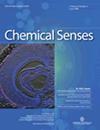人类麝香受体三部曲:将受体激活、基因型和感觉联系起来
IF 1.9
4区 心理学
Q1 BEHAVIORAL SCIENCES
引用次数: 0
摘要
麝香的香味在香水史上扮演着独特的角色。麝香气味由六种不同的化学物质组成,人类小组成员对其强度和质量的感知差异一直困扰着嗅觉研究领域。最近描述了三种麝香气味受体(OR):OR5AN1、OR1N2 和 OR5A2。通过修改 C 端结构域,实现了难以表达的人类 OR5A2 的高功能表达,并研究了这些受体三部曲及其关键基因变异体的感觉感知与受体激活之间的联系:在 440 种商用香料化合物中,这三种受体都只能检测到麝香味化合物。OR5A2 是多环麝香和线性麝香类以及大多数大环内酯的关键受体。单个 P172L 取代可将 OR5A2 的灵敏度降低约 50 倍。与此同时,同基因突变的人类专家对选择性 OR5A2 配体的感官检测阈值也会提高约 40-60 倍。对于大环内酯,体外激活与体内感官检测阈值之间的强相关性进一步证明 OR5A2 是关键的 OR。OR5AN1是感知大环酮类(如麝香酮和某些硝基麝香酮)的主要受体,因为具有突变体OR5A2的小组成员对这些配体仍然同样敏感。最后,OR1N2 似乎是另一个参与感知天然 (E)-ambrettolide 的受体。这项研究首次将OR激活与对这一类独特气味的感知和基因多态性联系起来。本文章由计算机程序翻译,如有差异,请以英文原文为准。
The trilogy of human musk receptors: Linking receptor activation, genotype and sensory perception
The scent of musk plays a unique role in the history of perfumery. Musk odorants comprise six diverse chemical classes and perception difference in strength and quality among human panelists have long puzzled the field of olfaction research. Three odorant receptors (OR) had recently been described for musk odorants: OR5AN1, OR1N2 and OR5A2. High functional expression of the difficult-to-express human OR5A2 was achieved by a modification of the C-terminal domain and the link between sensory perception and receptor activation for the trilogy of these receptors and their key genetic variants was investigated: All three receptors detect only musky smelling compounds among 440 commercial fragrance compounds. OR5A2 is the key receptor for the classes of polycyclic and linear musks and for most macrocylic lactones. A single P172L substitution reduces sensitivity of OR5A2 around 50-fold. In parallel, human panelists homozygous for this mutation have an around 40 – 60-fold higher sensory detection threshold for selective OR5A2 ligands. For macrocyclic lactones, OR5A2 could further be proven as the key OR by a strong correlation between in vitro activation and the sensory detection threshold in vivo. OR5AN1 is the dominant receptor for the perception of macrocyclic ketones such as muscone and some nitromusks, as panelists with a mutant OR5A2 are still equally sensitive to these ligands. Finally, OR1N2 appears to be an additional receptor involved in the perception of the natural (E)-ambrettolide. This study for the first time links OR activation to sensory perception and genetic polymorphisms for this unique class of odorants.
求助全文
通过发布文献求助,成功后即可免费获取论文全文。
去求助
来源期刊

Chemical Senses
医学-行为科学
CiteScore
8.60
自引率
2.90%
发文量
25
审稿时长
1 months
期刊介绍:
Chemical Senses publishes original research and review papers on all aspects of chemoreception in both humans and animals. An important part of the journal''s coverage is devoted to techniques and the development and application of new methods for investigating chemoreception and chemosensory structures.
 求助内容:
求助内容: 应助结果提醒方式:
应助结果提醒方式:


